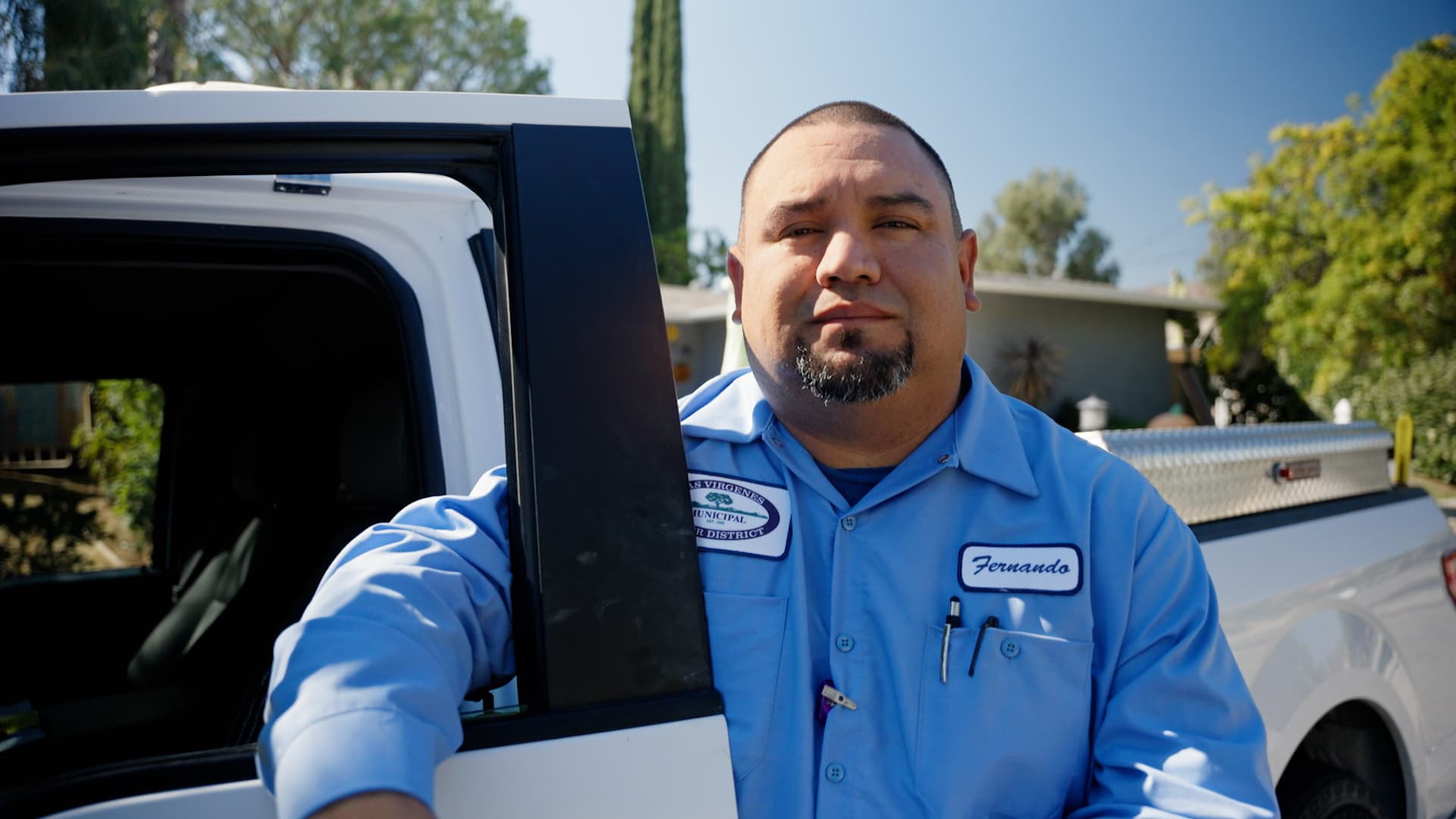
The promise of job security and work-life balance drew Fernando Gonzalez to become a water operator. Now that he’s worked as one for a few years, he sees his job as much more than fining people for using too much water.
On a given day, he’s patrolling neighborhoods spanning from farmland to Malibu mansions, looking for evidence that residents are wasting water. He hands out notices of leaky sprinklers or when residents run sprinklers right after a rainstorm, sure, but the most rewarding part of his job is interacting with customers about how they can save water, and why it’s so important.
“We’re more of a teaching tool than we are a kind of enforcement,” Gonzalez, 43, tells CNBC Make It. “We’d rather spend more time with customers and actually give them pointers on how they can conserve, rather than just hand out blank fines and collect the money and run.”
The stakes have never been higher as Southern California and the rest of the southwestern U.S. continues its 20-plus years in a megadrought. It’s the driest period for the region in over 1,200 years, according to Nature Climate Change.
“Climate change has made a big difference to to how our hydrological cycle is being affected,” Gonzalez says. “You see the lakes running low. You see the the wildlife being affected. You can see that animals are coming down out of the mountains into urban areas to eat because their food sources are being affected up where they normally live.”
Fernando Gonzalez, 43, makes $70,000 a year as a water operator based in Calabasas, Calif.
Tristan Pelletier | CNBC Make It
Gonzalez sees the direct line between the work he does and affecting behavior change that can help conserve California’s precious water resources, even though talking to residents and news teams about climate change isn’t what he signed up for at all: “I never thought I’d be using my voice as a tool,” he says. But this is the reality of what we have to do in order to conserve water.”
Here’s how Gonzalez earns $70,000 a year, or nearly $100,000 with overtime, as a water operator in Calabasas, Calif.
Getting the job
Gonzalez was born and raised in California and helped run his dad’s pool cleaning business until age 25. During that time, he learned a lot about water chemistry and that he loved working outdoors. In his 20s, he changed careers to work as a plant manager in industrial sales and distribution, but realized he didn’t like working a desk job and wanted something different.
When Gonzalez noticed his clients who worked for a water agency were always in a good mood, could spend a lot of time with their families and even had energy for hobbies, he wanted in.
In 2017, Gonzalez enrolled in community college, took six courses and got certified by the California State Water Resource Control Board to work as a water operator.
Fernando Gonzalez is on the frontlines of combatting the historic “megadrought” in the southwestern U.S., and works with customers across parts of Los Angeles County to conserve water in the desert.
Tristan Pelletier | CNBC Make It
The biggest surprise during his studies was learning about the legal regulation of how water moves throughout the state of California to Los Angeles County. “It really brought to light the scarcity of the water here in Southern California,” he says. “I found out the water comes from Northern California, and we don’t actually store any water here in the south. So that made it real on the water conservation effort.”
Learning about the chemistry of water treatment — how acid, chlorine and different chemicals affect water — was a challenge, but Gonzalez learned to like it. “If you have a passion for something, you always find a way,” he says. “And I found that I had a passion for this, and it really did hit home for me.”
Water operators are required to hold either a water distribution license or a treatment license. Gonzalez currently holds both. He was hired at Las Virgenes Municipal Water District, which serves about 75,000 residents in western Los Angeles County, in January 2020.
A day on the job
Gonzalez wakes up at 3 a.m., leaves his house by 4 a.m. and gets to work by 5 a.m. His shift doesn’t usually start until 7 a.m., so he’ll put in some overtime hours in the morning doing drought patrol and working with the Pure Water Project, an initiative to purify recycled water for continued use.
Gonzalez enjoys the variety of his work. Depending on his assignments for the day, he could be doing meter readings digging to install new plumbing or interacting with customers.
His district is one of the top water users in the state of California. Last year, customers used an average of 205 gallons per person per day, according to reporting from the Los Angeles Times, and about 70% of residential water use is for landscaping.
Fernando Gonzalez says job security, work-life balance and the ability to work outdoors drew him to becoming a water operator. He also enjoys interacting with customers and teaching them how to conserve water.
Tristan Pelletier | CNBC Make It
The typical neighborhoods he works in can range from traditional single-family lots to farms with horses, as well as celebrity mansions owned by the likes of Kim and Kourtney Kardashian, Dwyane Wade and Kevin Hart — many of whom have been issued notices of excess water usage.
Fines range from $50 to $100, which are often “not enough of a deterrent for people who have the means and the money to just pay their way out of it,” he says.
And violations can bring up uncomfortable conversations with homeowners who worry that if they don’t water their lawns, their plants will die, and their property value could drop.
But Gonzalez reminds them that if the California drought gets worse, water use could be restricted to only human consumption. The consequences could be much worse than dull lawns. “It’s unfortunate, but there is going to be a casualty to the drought, and we prefer the casualty be the lawn over the people,” he says.
If a customer exceeds their water budget too many times, the district installs a flow restrictor — a washer with a 1/16-inch hole in the center that allows just under two gallons of water per minute to go to the house.
Properties that go over their water allotment too many times have a flow restrictor installed, which is a washer with a 1/16-inch hole in the center that allows just under two gallons of water to flow per minute.
Tristan Pelletier | CNBC Make It
The restrictors make customers re-prioritize their water use: “You’ll have to actually start making kind of decisions on what’s more important — watering your lawn or taking a shower — because you can’t do both at the same time with the restrictor in,” Gonzalez says.
Gonzalez approaches his work with empathy: People aren’t wasting water to be malicious. Usually, customers just pay their water bill and don’t think twice about it. It isn’t until someone like him visits their property, finds a leak and works with them to get it repaired that they realize they’re wasting water.
“It’s a win for everybody,” Gonzalez says. “Conservation-wise, it’s less wasted water, and the customer wins because their water bill will go down.”
Overall, “one of the biggest rewards for me is still the customer service aspect of it, of helping the community with what I do,” he says.
The future of water
Gonzalez also works on the Pure Water Project, an initiative that uses emerging technologies to treat recycled water for irrigation. The ultimate goal is to bring the treated water up to safe drinking standards one day.
In the mornings, Gonzalez will work in a lab to monitor the facility’s three-step filtration process, make adjustments to the system, and measure the impact of how pure the water comes out.
“Climate change has made a big difference to to how our hydrological cycle is being affected,” says Fernando Gonzalez. “You can see that animals are coming down out of the mountains into urban areas to eat because their food sources are being affected up where they normally live.”
Tristan Pelletier | CNBC Make It

